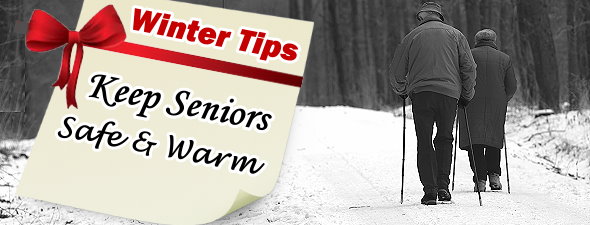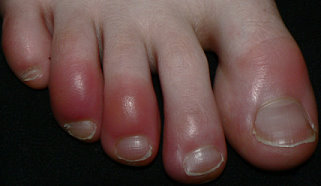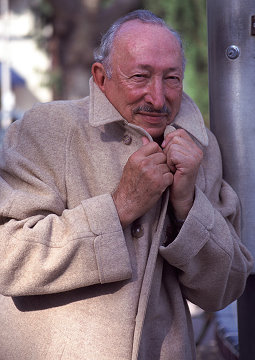Well, the calendar on my wall claims that winter won’t start until next week but you could have fooled me. It’s freezing out there. Back in July we shared 10 Ways for Seniors to Keep Cool, given the frigid weather outside now seems like a good time to follow up with some advice on keeping Seniors warm and safe this winter.
 Winter is one of the most dangerous seasons for Seniors. The weather makes it difficult for them to get around, further isolating them from friends and help. They are more vulnerable to the extreme cold. It is the season of influenza, which each year kills tens of thousands of Seniors and hospitalizes hundreds of thousands more. The freezing weather drastically increases Senior’s risk of falls, putting them at additional risk of injury.
Winter is one of the most dangerous seasons for Seniors. The weather makes it difficult for them to get around, further isolating them from friends and help. They are more vulnerable to the extreme cold. It is the season of influenza, which each year kills tens of thousands of Seniors and hospitalizes hundreds of thousands more. The freezing weather drastically increases Senior’s risk of falls, putting them at additional risk of injury.
Keeping Seniors Safe in the Winter
- Winter Footwear: When heading outside wear footwear with non-slip soles and thermal socks. This will help prevent falls and will keep feet nice and warm.
- Slip Prevention: It’s important to keep steps, driveways, and walkways as free of ice as possible; sprinkle them with a mixture of salt and sand. Don’t hesitate to ask for or hire help. A well positioned Grab Bar or Rail on a flight of slick steps can literally be a lifesaver and an Ice Attachment for Canes can give Seniors some added traction when they’re out and about in icy terrain.
Keeping Seniors Healthy in the Winter
- Eat Well: Seniors should eat hot nutritious meals with plenty of fruits and vegetables. Dale Carter has pointed out that special care should be taken to avoid dehydration, which can be hard to identify during the colder months.
- Seasonal Vaccinations: Seniors should be annually vaccinated against the pneumonia and flu. The Center for Disease Control recommends getting the vaccine as soon as it becomes available because it takes the body about two weeks to build up an immunity. For more information visit Flu.gov.
- Stockpile Medicines: Stock up on common medicines for sore throats, colds, and coughs. Order prescription drug refills in advance so that there’s no reason to go out in bad weather.
- Keep Active: Moving around produces body heat and is good for general well-being. During the winter don’t sit still for more than an hour, get up, walk around, and make a warm drink. Spread activities throughout the day. Seniors who have difficulty walking can do chair-based exercises. Another major benefit of moving around is improved circulation, which helps prevent Perniosis and spread heat throughout the body.
- Perniosis: When a person gets cold and warms their skin too quickly they can develop perniosis, also known as chilblains. These itchy, red swellings often occur on the feet, finders, nose, and ears. People with poor circulation are especially vulnerable. Perniosis is a common condition that can be easily treated by applying calamine or witch hazel to the swelling to reduce itching, it’s important not to scratch the swellings as this could break skin and result in an infection. To prevent Perniosis avoid rapid changes in temperature, wear warm footwear, gloves and socks, avoid tight fitting clothing that impedes circulation, and do not drink alcohol before going out into the cold.
Keeping Warm in the Winter
- Wear Layers: It is warmer to wear several thin layers of clothing than one thick layer. Wool and cotton fibers help to hold warmth in. Thermal underwear or tights make for a good under-layer.
- Cover Head, Feet, and Hands: The U.S. army field manual for survival states that 40% to 45% of body heat is lost through the head, to prevent this heat loss in cold weather it is important to wear a warm hat. Warm gloves and footwear are equally important to keep hands and feet warm.
- Dress for the Cold…even indoors: Wear warm clothing indoors, even overnight in bed. This can be more effective than cranking up the heat and will certainly be more efficient.
Our fellow Pennsylvanian Peter Leer shared the following Winter Caregiving Tips on Wheelchair Outings along with many more on his blog at CaregivinglyYours.com.
- Body Heat: Don’t forget that a person riding in a wheelchair does not produce the same amount of body heat as a person walking.
- Scarfs: In Peter’s own words, “While a hat and scarf are often recommended I have concerns about mixing scarves and wheelchairs, seems an accident waiting to happen.”
- Outerwear: Again, in Peter’s own words, “For outerwear we usually rely upon a hooded wool zippered cape. Capes are easier for getting on and off when assisting someone in a wheelchair and a zippered cape simply increases options. Hoods are easy to flip up or down, cover everything except the face and are always attached. While wool is ‘old school’ it still has the unique ability to provide warmth even when it is wet.”
- Don’t forget the lower body: A warm blanket or leg warmers help to keep in body heat and reduce wind chill.
Did we miss anything? Share your Winter Caregiving Tips in the comments.


